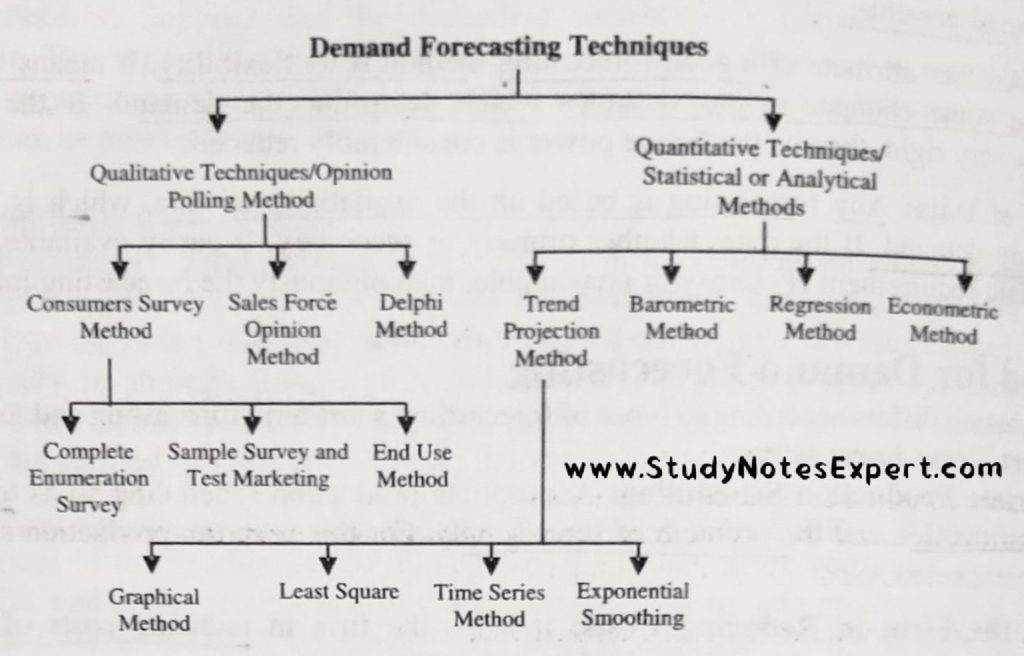After analyzing and interpreting the data and subsequently, the information that is obtained from various primary and secondary sources, the next step is to adequately predict the future demand for the underlying product the service. Demand forecasting techniques help in analyzing data. For this, you have knowledge about the theory of demand.
Demand Forecasting Techniques

1. Qualitative Techniques/Opinion Polling Method
This method is characterized by the opinion of different forces that drives the demand i.e. buyers, experts, retailers, etc. The opinion polling methods of demand forecasting techniques are many types :
A. Consumer Survey Methods
The survey method is the most commonly used direct method in the short run for the projection of the demand. Under this demand forecasting techniques, different surveys are organized in routine to gather information about the likes and dislikes of the buyers and the probable future purchases. Survey methods include:
1. Complete Enumeration Survey
The survey is done by visiting all the houses during the forecast and all the household opinions are taken into consideration. These demand forecasting techniques help in completing the survey.
Advantages of Complete Enumeration Survey
i) Quite accurate as it surveys all the consumers of a product.
ii) It is simple to use.
iii) It is not affected by personal biases.
iv) It is based on collected data.
Disadvantages of Complete Enumeration Survey
i) It is costly.
ii) It is time-consuming.
iii) It is difficult and practically impossible to survey all the consumers.
iv) The size of the data increases the chances of faulty recording and wrong interpretation.
v) Useful only for products with limited consumers.
2. Sample Survey and Test Marketing
Rather than contacting all the households, some households are selected randomly and their opinions are sought. The sample is the true indicator of the population. As a result of the sample survey, test marketing has evolved. Under this demand forecasting techniques, the product is handed over to the different users on a random basis for a specified time and their responses are noted down.
Advantages of Sample Survey
i) An important tool especially for short-term projections.
ii) It is simple and does not cost much.
iii) since only a few consumers are to be approached the method works quickly.
iv) The risk of erroneous data is reduced in this demand forecasting techniques.
v) This method gives excellent results if used carefully.
Disadvantages of Sample Survey
i) The conclusions are based on the view of only a few consumers and not all of them.
ii) The sample may not be a true representation of the entire population.
3. End-Use Method
It is one of the demand forecasting techniques. A demand survey is conducted for the industries that are actively using the product as an intermediate. The consumption of the intermediate product is considered as the base for the future projections of the final product in this demand forecasting techniques.
Advantages of End-Use Method
i) The method yields accurate predictions.
ii) It provides sector-wise demand forecasts for different industries.
iii) It is especially useful for producer’s goods.
Disadvantages of End-Use Method
i) It requires complex & diverse calculations.
ii) It is costlier as compared to the other survey methods & is more time-consuming.
iii) Industry data may not be readily available.
B. Sales Force Opinion Method
It is also termed as Collective Opinion Method. Under this, rather than approaching the consumers of their opinions, those are affected by the sales are given priority the shopkeeper and the salesman.
Advantages of Collective Opinion Method
i) Perhaps the simplest of the forecasting methods.
ii) It is less costly.
iii) Collecting data from its own employees is easier for a firm than doing it from external parties.
Disadvantages of Collective Opinion Method
i) Consumer’s tastes and preferences keep changing with time. What held well in the past may not necessarily continue to do so in the future as well. The opinion of the sales force may thus be erroneous.
ii) The sales force may give biased views as the projected demand affects their future job prospects.
C. Delphi Technique
It comprises of certain rounds of structural surveys and those who participate in the survey are the experts of their own field. This survey is conducted in different rounds and the results of the initial rounds are given as feedback in the later round for the purpose of follow-ups. In this demand forecasting techniques can be observed that the expert’s responses in the second round are influenced by the opinion of the others. It is basically a group communication system structured for surveys so that incomplete information or knowledge is utilized to derive the most appropriate outcomes.
Advantages of Delphi Technique
i) It is simple to conduct.
ii) Can be used where quantitative data is not possible.
iii) The forecast is reliable as it is based on the opinion of people who know the product very well.
iv) It is inexpensive.
v) It takes little time.
Disadvantages of Delphi Technique
i) The results are based on the mere hunch of one or more persons and not on scientific analysis.
ii) The experts may be biased.
iii) The method is subjective and the forecast could be unfavourably influenced by persons with vested interests.
2. Quantitative Techniques/Statistical or Analytical Methods
A. Trend Projection Method
It is one of the demand forecasting techniques. The data of the past can be used as a stepping stone for future demand projections. A trend can be established on the basis of the past figures. Such a trend can be graphically or equatorially established, The trend can be estimated by using any one of the following methods:
1. Graphical Method
Past data on sales in different regions are plotted on the graph and the sales trend line is drawn by joining all the points. The line shows the most likely trend which may be upward or downward. Only the direction of the trend is reflected but the actual figures cannot be predicted precisely.
2. Least Square Method
This method assumes consumption that the previous rate of change continues to prevail in future. A trend line is drawn mathematically considering the past data in a manner that the difference between the calculated and of observed value is minimum. A trend line in demand forecasting techniques is formed which is the best fit for the data that is available. The trend line is based on two variables, where one variable is dependent and the other variable is independent. The value of the independent variable is put forth to estimate the value of the dependent variable. This method of demand forecasting techniques is simple to use and the cost associated with this method is also very less.
3. Time Series Methods
These methods (graphical and least square) are dependent upon analysis of the past data. Just like the other methods, this method also assumes that past data can be effectively used to predict the future demand of the product.
i) Average: It is the arithmetic mean of all observations.
ii) Trend: Timely increase/decrease in the outcome over different periods.
iii) Seasonal Influence: Other cyclic behaviours that also remain constant over different time periods i.e. daily, monthly, seasonally, yearly, etc.
iv) Cyclical Movement: It refers to the unpredictability as a result of long-term cyclical behaviours because of the lifecycle of a product or a service.
v) Random Error: Other aspects that were not covered by the above four components.
4. Exponential Smoothing
It is the fourth method in drawing the trends. Under this method, the past data of demand is used considering the weights. The weights used are however exponential in nature. Higher weights are allotted to the most recent period and it goes on decreasing exponentially as we go down.
Advantages of Trend Projection Method
i) It is a very simple method.
ii) This method of demand forecasting techniques provides reasonably accurate forecasts.
iii) It is quick and inexpensive.
Disadvantages of Trend Projection Method
i) Can be used only if past data is available.
ii) It is not necessary that past trends may continue to hold good in the future as well.
iii) There is no analysis of causal relations between the demand and time series explaining the whys of it.
B. Barometric Method
This method is also termed ‘leading indicators forecasting’. The National Bureau of Economic Research of the U.S.A. has spotted three different indicators under this method i.e. leading indicator, co-incidental indicator and lastly the lagging indicator. To have better result a relationship between sales of product and economic indicators need to be studied to arrive at an accurate projection of sales and study the effect of the indicators on the sales.
Advantages of Barometric Method
i) It is a simple method.
ii) It predicts directional changes quite accurately.
Disadvantages of Barometric Method
i) It does not predict the magnitude of changes very well.
ii) Finding out a leading indicator for any series is not always feasible.
iii) The lead time is maintained consistently by very few time series.
iv) The method can be used for only short-term forecasts.
C. Regression Method
This is one of the most commonly used demand forecasting techniques. Here, the relation between quantity demanded being a dependent variable and other independent variables like price, income, price of substitutes, etc. is established and a regression equation is formulated as Y = A + BX. Such relation between the dependent and the independent variables is often a linear one but sometimes it may also be curvy-linear.
Advantages of Regression Method
i) As the method is based on causal relationships, it produces reliable and accurate, results.
ii) Besides generating the forecast, it also explains the economic phenomenon.
iii) It is neither as subjective as the qualitative techniques nor as mechanistic as the quantitative ones.
iv) This method not only forecasts the direction but also the magnitude of the change.
v) The method is quite consistent.
Disadvantages of Regression Method
i) The method uses complex calculations.
ii) It is costly and time-consuming.
iii) It requires the use of some other demand forecasting techniques for estimating the value of the causal variables.
D. Econometric Model
The econometric model of demand forecasting techniques involves estimating several simultaneous equations, which are, generally, behavioural equations, mathematical identities and market-clearing equations.
Advantages of Econometric Method
i) This method possesses all the advantages of the regression method.
ii) If one is not worried about the size of the model, it can almost eliminate the regression method’s major problem of demand forecasting techniques, and the values of the independent variables in the prediction period.
iii) Provided the data are available, one should not really be concerned with the model’s size, for the computer is there to help the forecasters to estimate and solve the model.
Disadvantages of Econometric Method
i) To the extent the structural changes have taken place, the past relationship between independent and dependent variables will not continue in the future.
ii) The forecasts under this method assume that the forecast equation holds exactly in the prediction period. To the extent it is stochastic, i.e., the disturbance term is non-zero, the forecasts will be wrong.
Conclusion
By leveraging superior techniques and information-pushed evaluation, businesses can gain insights into consumer behaviour, market trends, and capability demand fluctuations. Accurate call for forecasting permits powerful stock management, production planning, and aid allocation. Ultimately, it led to stepped-forward patron pleasure, optimized operations, and accelerated profitability. Embracing and implementing strong calls for forecasting techniques is a strategic choice that empowers corporations to stay beforehand of the competition and adapt to changing marketplace dynamics.

